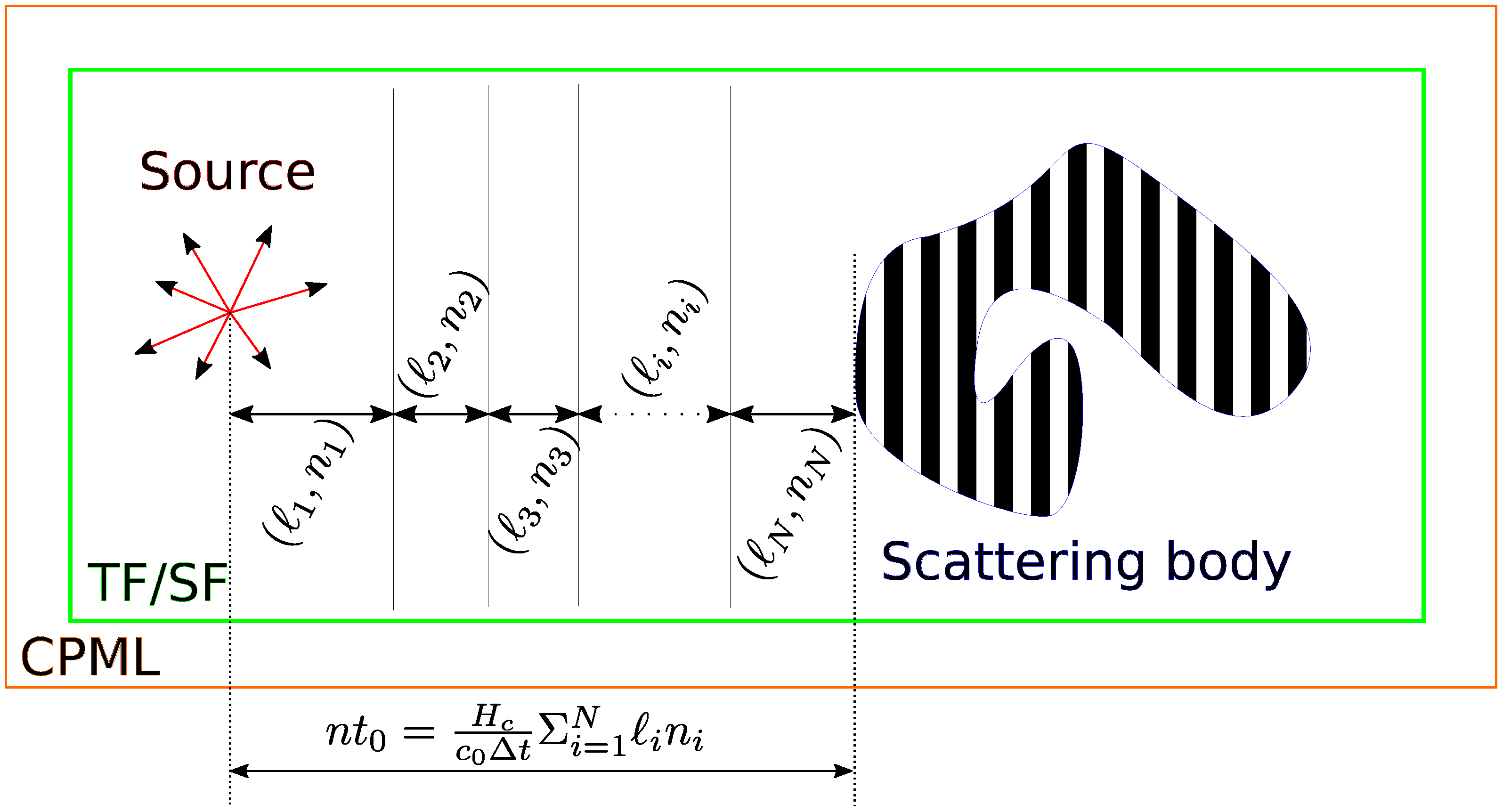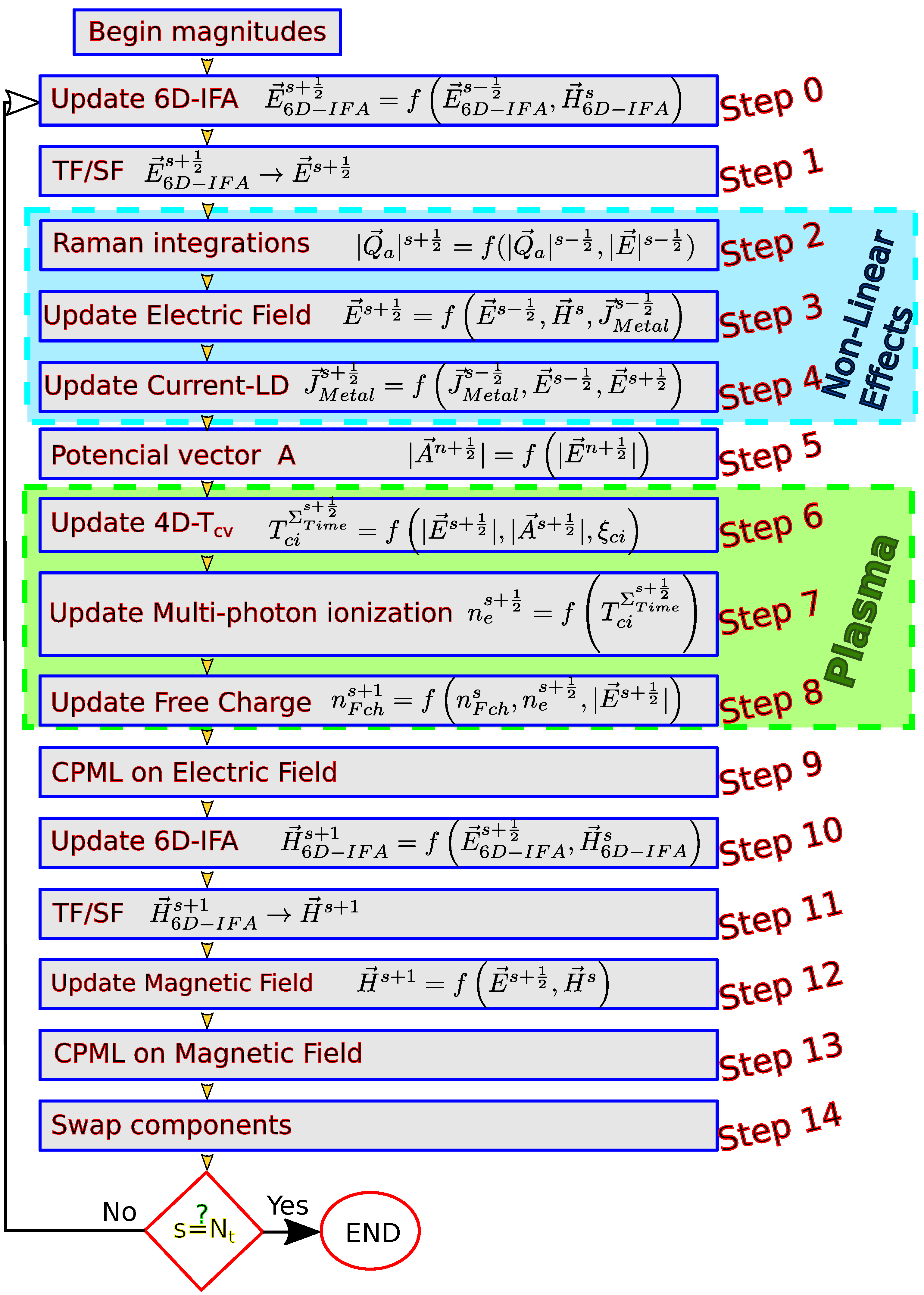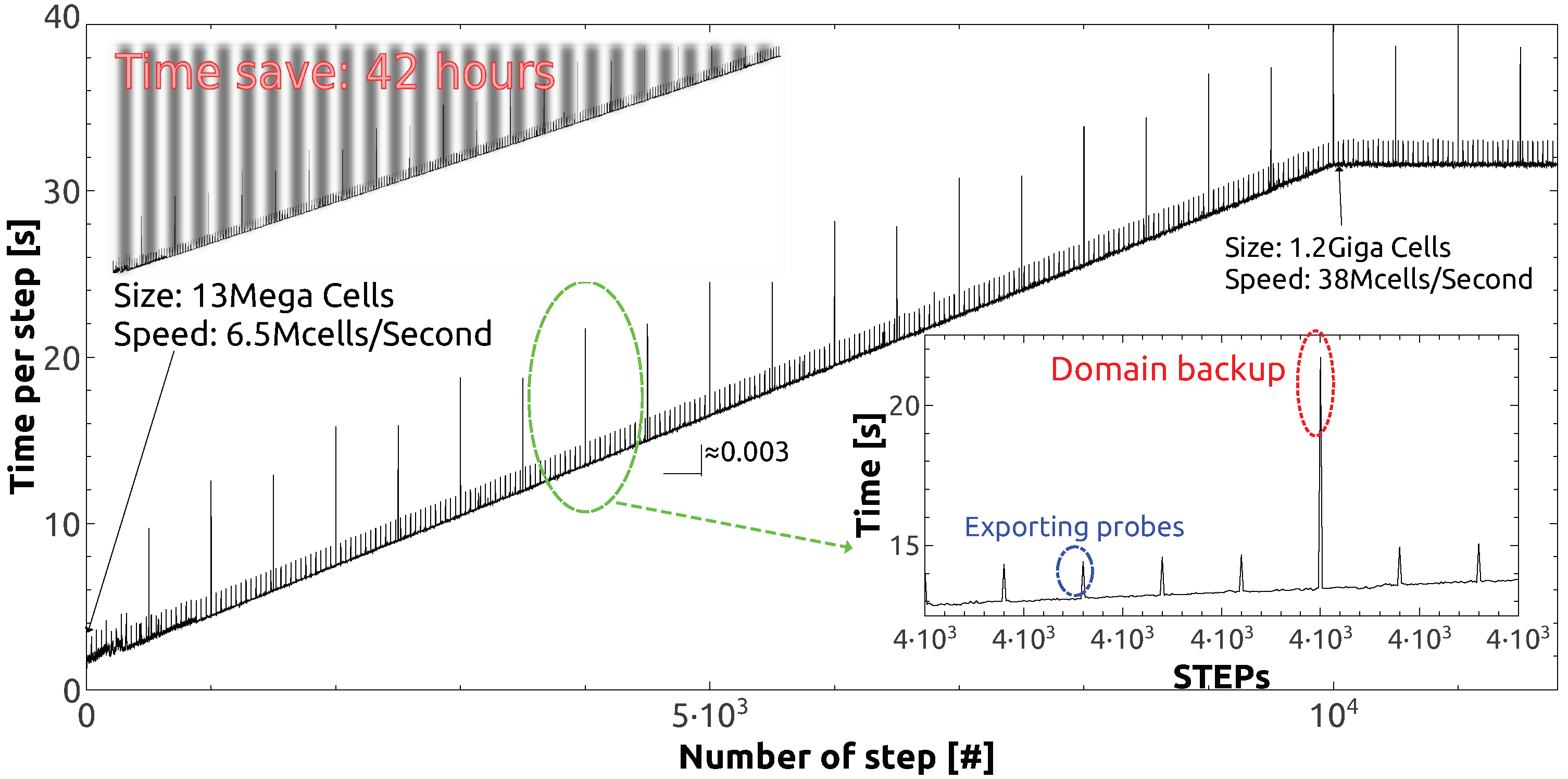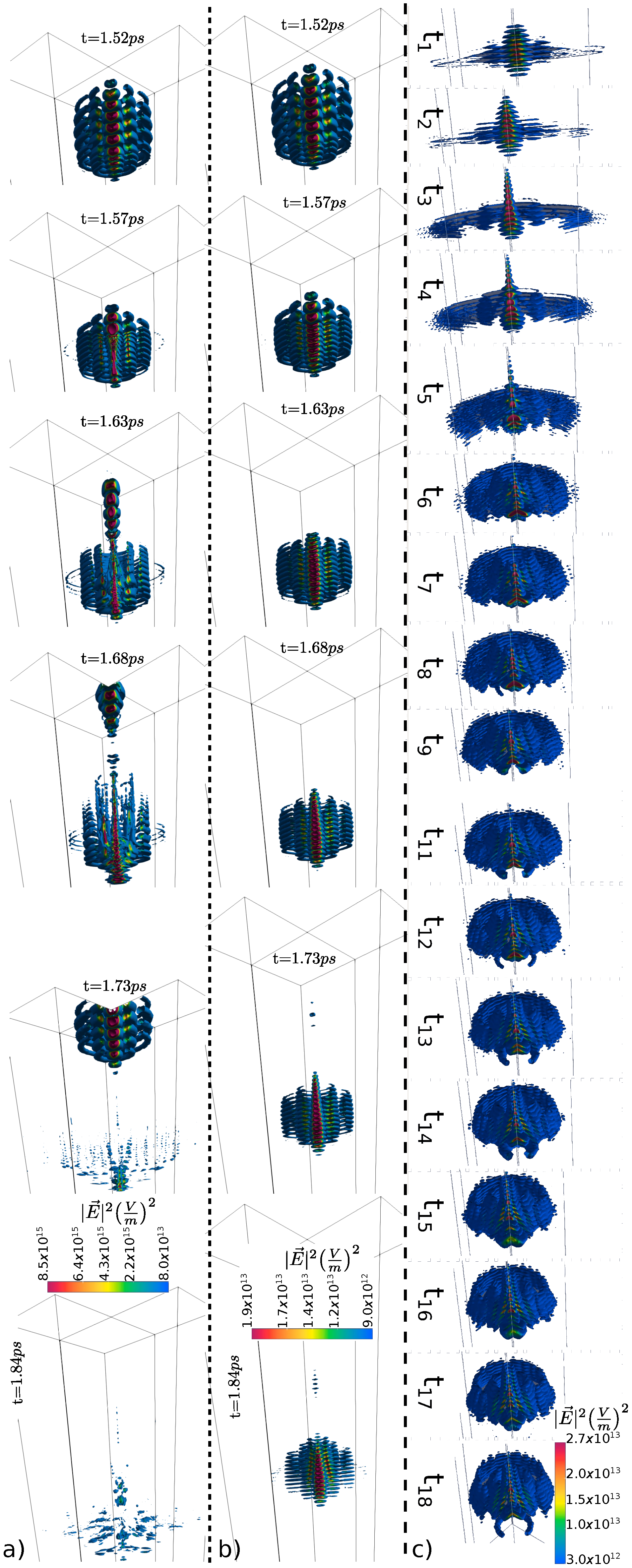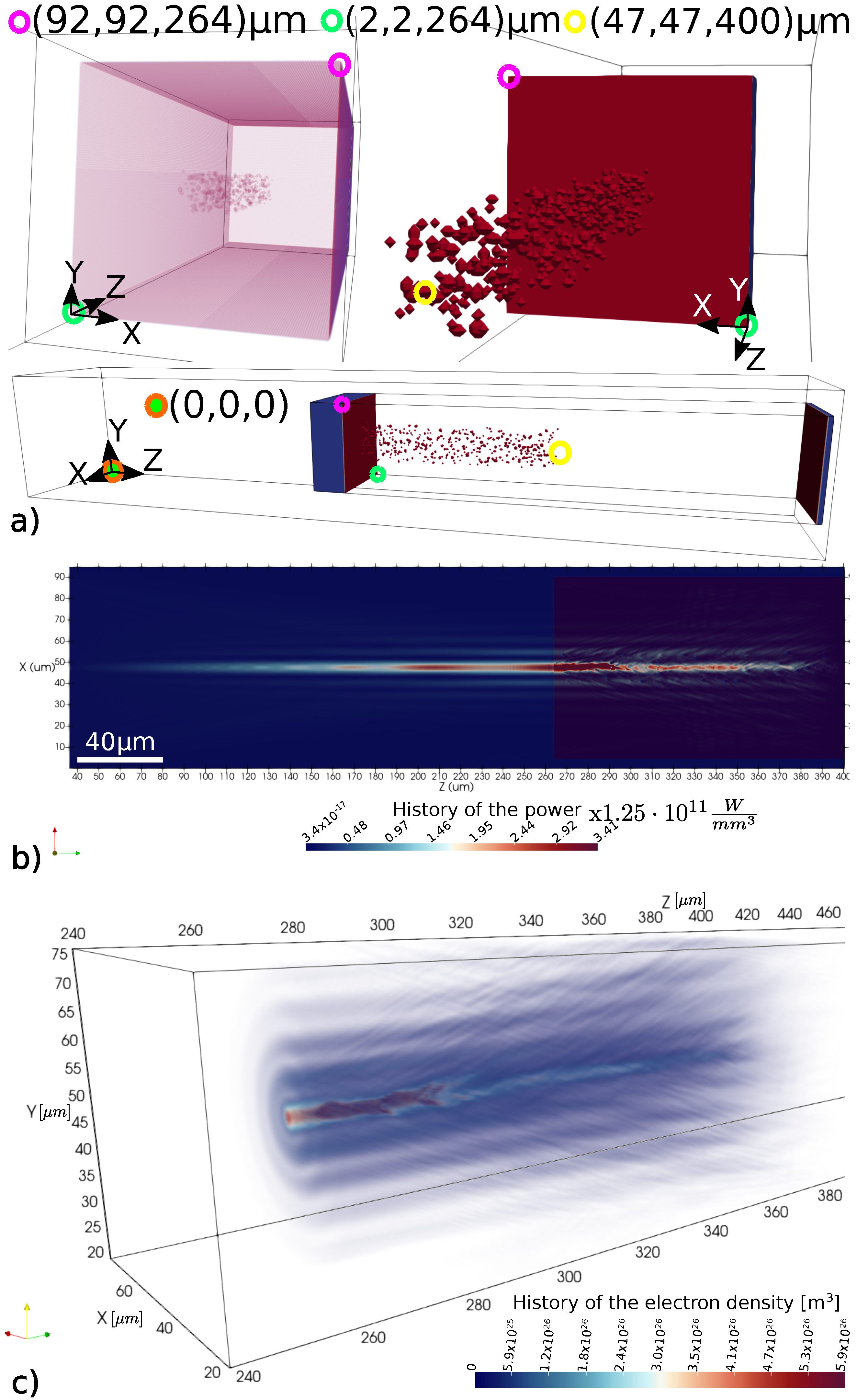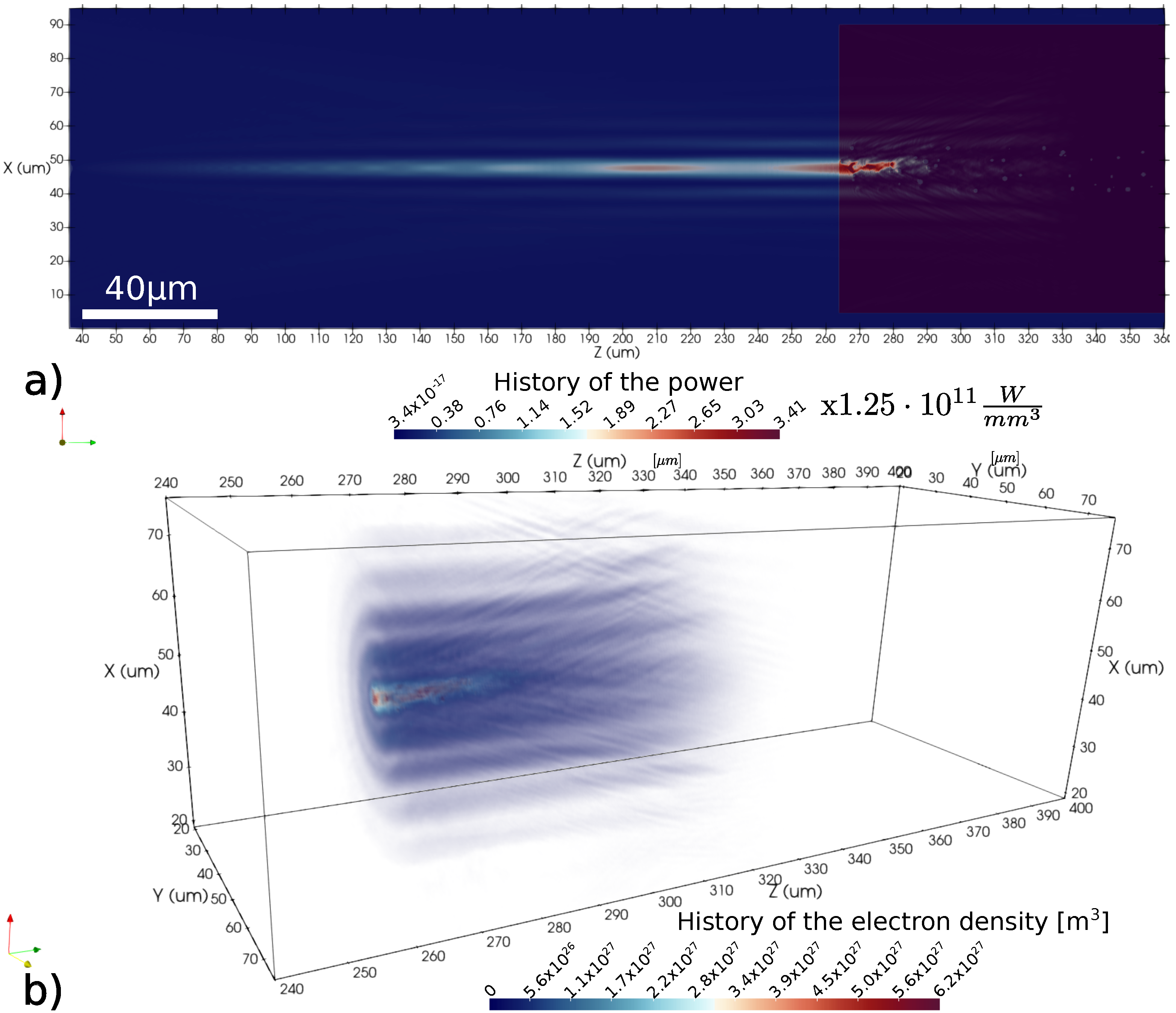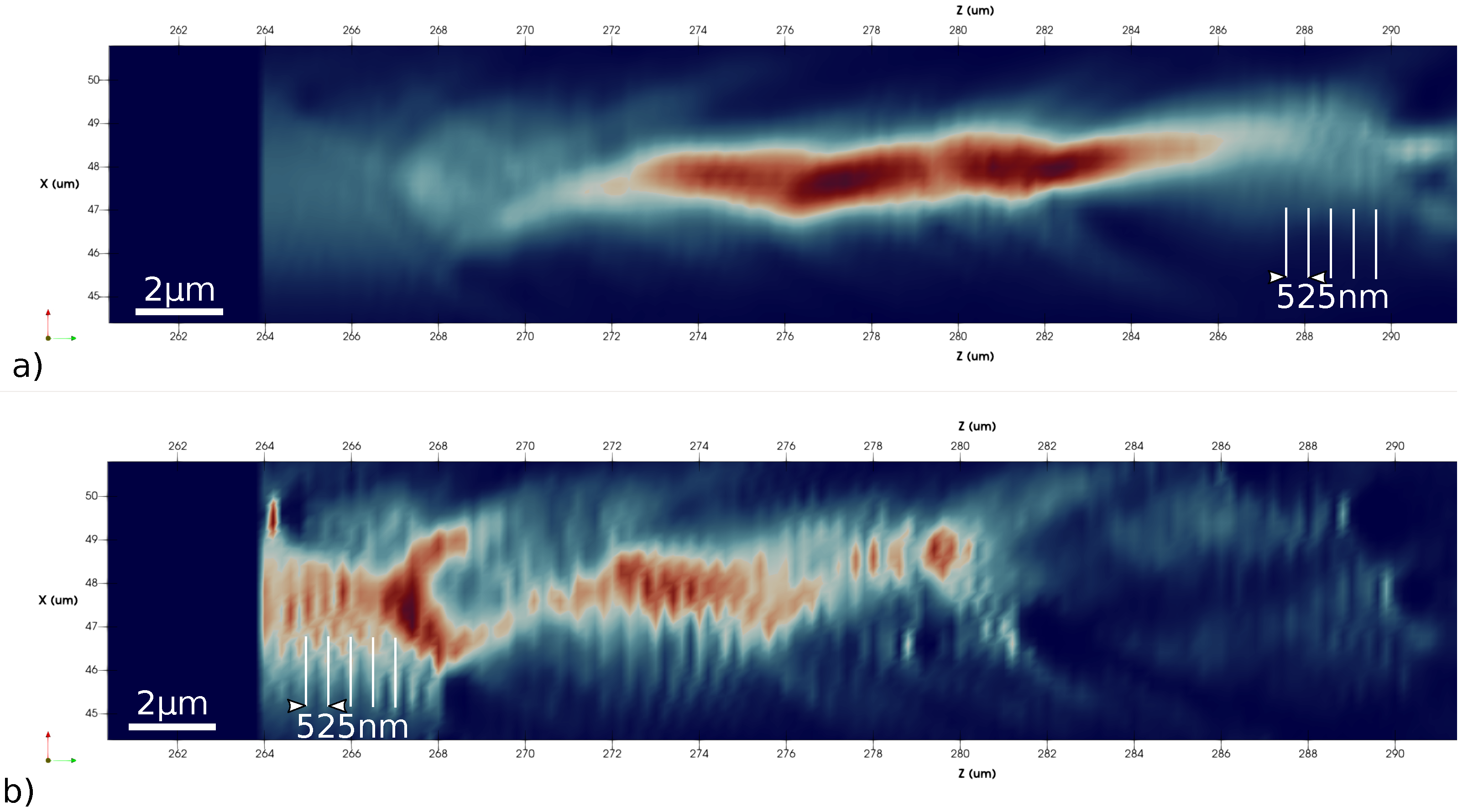1. Introduction
The finite difference time-domain (FDTD) method enables the computation and modeling of light propagation and scattering processes in linear and nonlinear dispersive materials possessing wavelength-dependent and intensity-dependent properties. This ranks the method among the most universal and powerful numerical tools for optics, electrodynamics, antennas, and waveguides theory. In this context, the general vector auxiliary differential equation (GVADE) method, which has been reported in [
1] and improved in [
2], is one of the most popular methods to deal with nonlinear media. However, the method suffers from some drawbacks that limit its speed and stability due to the semi-implicit updating relation for the current polarization densities. In summary, the method is not appropriate or recommended for a broad range of problems, especially those that address the designs with complex 3D topology, where iterative solutions of coupled nonlinear equations can be unstable and resource-demanding [
3]. Some direct or explicit methods take into consideration the Kerr effect in the Born–Oppenheimer approximation [
4]. The Kerr effect arises from the nonlinear third-order electric susceptibility. In [
3], the authors take into consideration the Kerr effect in an explicit form. Other direct methods [
5] require excessive computational burdens, especially for the consideration of complex geometries. When metal–dielectric interfaces are treated, especially at nanometric scales, plasmonic effects appear [
6,
7] and generate high concentrations or high local densities of the electromagnetic field [
8]. Since dielectrics experience nonlinear optical processes, the treatment of these regions in the interfaces is particularly challenging.
In this manuscript, we develop an algorithm that permits solving a nonlinear dielectric medium in which Kerr and Raman’s effects [
9] occur simultaneously. The Raman effect arises from the scattering caused by the conversion of photon energies into vibrational energy of molecules. The scattered photons have less energy than the incident photons corresponding, therefore lowering frequency fields [
2]. We also assume that this takes place in an inhomogeneous dielectric environment that can potentially include metallic heterogeneities with specific optical properties. Along with the laser propagation, provided that the intensity is sufficient to ensure nonlinear absorption, the medium can also turn into a metallic state as a free electron population is generated during multiphoton absorption (MPA) or tunneling and avalanche ionization processes. It is well known that the electron transition from the valence band (VB) to the conduction band (CB) is followed by various processes, including heating in the CB, impact ionization, and various kinds of electron collisions. The purpose of this work consists of computing all these events in a full explicit form. The carrier generation rate
has been computed owing to the BVkP approach implying Bloch–Volkov states [
10]. The algorithms presented in this manuscript are especially suitable for simulations dealing with confinements and guiding high-energy pulsed beams. In summary, in this work, we coupled Maxwell equations and the electric charge carriers conservation equation in which the quantum ionization and recombination are governed by BVkP self-consistently.
In the next sections, by following and enriching some pioneers’ works [
11,
12,
13], we detail a fully explicit, stable algorithm based on GVADE FDTD, able to solve the curl Maxwell’s equation in a frequency-dependent way for a nonlinear medium. In order to illustrate the combination of all these nonlinear effects occurring simultaneously in a simulation, we have modeled a Bessel beam traveling through dielectric fused silica, where some metal inclusions are modeled in a similar form as in Ref. [
14]. In
Section 2, we introduce the theoretical model, which describes the nonlinear effects.
Section 3 presents the algorithms that discretize in time and space the main magnitudes, electromagnetic fields and electric charge.
Appendix A is devoted to the stability condition assessment for these algorithms, which imposed numerical limits to the simulation performance. These limits are studied in
Section 4, where we specify the validity framework considering natural limits imposed by physics. In
Section 5 we present the simulation outcomes provided by the full numerical modelling and in
Section 6 the conclusions are drawn. Finally, the stability conditions are derived in
Appendix A and the used computational resources are presented in
Appendix B.
2. Modeling Electromagnetic Fields in Nonlinear Media
The Equations (1)–(3) model the laser beam propagation by means of the electromagnetic fields
and
. Throughout the light propagation path, fields generate and couple with the density of free charges as free electrons
, which in turn interact with the local field. In the given form, nonlinearities are determined by the electric displacement field
in the Ampère-Maxwell Equation (1). Meanwhile, the evolution of the free-electron density or medium conductivity is described by Equation (3), where
is the carrier generation rate and
is the carrier recombination rate.
The electric displacement field is composed by the electric field contribution plus the polarization vectors
[
2]. The magnitude
is the non-unity high-frequency relative permittivity of the media. On the right hand side of the displacement electric field, the sum of polarization vectors in the model that we are considering
is the contribution of four terms, the metal polarization
, the Kerr effect polarization
, the Raman polarization
and the free charge polarization vector
such as
with the detail of each term below:
where
is a coefficient gathering parameters depending on the considered medium. Expressions Equations (5) and (6) providing the Kerr effect polarization and Raman polarization, respectively, are taken from [
9]. Here,
is a real-valued constant in the range
that parameterizes the relative strengths of Kerr and Raman contributions,
refers to the Dirac delta function that models the Kerr nonresonant virtual electronic transitions, which is medium dependent and in the order of few femtoseconds for fused silica,
is the Heaviside unit step function,
models the impulse response of a single Lorentzian relaxation centered on the optical phonon frequency
and having a bandwidth of
. Finally
is the strength of the third-order nonlinear electric susceptibility.
The upper limit of the integrations in Equations (5)–(7) extends only up to
t because the response function must be zero for
to ensure causality [
3]. Moreover, free-charge polarization is introduced by using a free-charge density of current, which will be defined later. Finally, to model the metal, we consider a complex electrical permittivity
where
a and
b are complex numbers that fit experimental data [
15]. To model the dispersive media, we assume an electric permittivity, which is frequency-dependent as the calculations are devoted to ultrafast laser propagation, with bandwidth-limited pulses that exhibit wavelength dispersion.
In ref. [
2], the general vector auxiliary differential equation technique allows considering nonlinearities or dispersive characteristics of a medium. They are introduced into the Ampère–Maxwell equation by means of current densities. These currents correspond intrinsically to the temporal variation of the polarization vectors. Thereby, the following Equations (8)–(11) can be derived to correlate the currents
,
,
,
with the electric field:
We define a free-charge density of current as an Ohmic current, where the conductivity
is given by the following frequency dependent expression:
where
q is the electron charge,
the free carriers of charge mobility,
the free-charge density and
the photo-ionized electron density. This definition for the density of current Equation (11) is similar to Equation (9) in [
10]. In Equation (13), we employ free-charge which is governed by Equation (3), or generation Equation (13) and recombination Equation (14) rates. In [
10], the authors explain that electron density
produced in the conduction band only describes the interaction of an electron with the laser electric field and accounts for the lattice periodicity, but does not account for possible collisions with phonons, ions, or other electrons. Due to these collisions, the coherence between the excited electron to the CB and its parent ion is destroyed and may introduce deviations from the above-predicted evolution of the electron density in the CB with respect to time. Indeed, without collisions, the produced electron density was shown to oscillate with time as a conduction electron may go back and forth to the VB through the action of the electromagnetic field [
10,
16]. Obviously, in an oscillation, the energy stays constant [
17]. Hence, the authors of [
10] defined a free state as a state where the electrons can be heated by inverse bremsstrahlung (IB) and are decorrelated from the parent ion. The density of charge associated with this free state is called here density of free-charge
, and its evolution along the time is modeled by Equation (3). Nevertheless, the
, the free carriers of charge mobility, then we employ experimental data, which allow the determination of this parameter. The method is explained in detail in
Section 5.
In the carrier generation rate, the term associated with the photo-ionized electron density
produced in the conduction band is a function of
. From Equation (5) in [
10] we know that
and hence
. If this constant
, then
when
. Combining this result with Equations (3) and (4) in [
10], we calculate
by Equation (15).
Finally the functions related to the generation by ionization
, impact
and avalanche
, as well as the function related to the recombination of the free-charge
, are given by the Equations (16)–(19), respectively.
In Equations (16)–(19), we find that the factor of maximum electric field reduction, which is suggested twenty times by [
10], is taken into consideration. Nevertheless, when the photoionization process is considered in a truncated region where the magnitude of
is from the beginning higher than the threshold
reference value, these logical conditions can be suppressed in the nested loops, and this increases the algorithm performance. In other words, this simplification is possible when we assume the description with nonlinear effects in a particular region of the computational domain. So, the electromagnetic field that arrives at that region has a magnitude higher than the threshold
.
In Equation (18), we assume that is the fluence with being the medium impedance. However, this is a particular case only valid when the electromagnetic field is a harmonic function in time. In general, and assuming a propagation along the z-axis, the power per surface is given by the Poynting vector.
3. Algorithms
The polarization vector due to the Kerr effect at the time
can be written as
; however, afterwards, at the instant
, in order to define a full explicit approach, we have to make the approximation
. This approximation was demonstrated in [
3] and leads to:
This approximation
is valid under particular physical conditions explained in
Section 4. To compute the nonlinear Raman effect, we make an analogous approximation. Considering that in this case there is no instantaneous cause–effect relationship, it is evident that the approximation is justified [
18]. Therefore, by defining the scalar magnitude
that is defined from the vector
, which could be considered as an instantaneous anisotropic Raman conductivity, we can discretize the Raman polarization vectors at the instants
and
as follows:
and
. Where
is updated from
by means of:
where the Raman response function for a particular medium is modeled by
and the time delay
, being
, depends on the refractive index of the media
as well as the location of the electromagnetic field in the media (
Figure 1). Here
is the Heaviside step function:
In this way, we obtain the Raman current density and the Kerr current density:
The current density updating associated to the metal is given by the equation:
where
and
. The operator
calculates the real part of these complex numbers. Finally, the electric field updating is given by the algorithm:
where the parameter
has different time-dependent values at the different locations:
where
implicates any region in metals or CPMLs, meanwhile
represents any computational region filled by a dielectric medium. Finally we have two parameters,
and
, that are defined as follows:
permits to switch the algorithm from dielectric to metal and vice versa.
is a coefficient gathering parameters for convenience in the metal current.
Table 1 summarizes the algorithms presented in this section, and
Figure 2 sketches the general flow chart. In the next section, we discuss the stability conditions for these algorithms.
In
Appendix A, we determine the stability conditions for the presented algorithms.
Table 2 summarizes the stability conditions of all these effects together or separately.
4. Performance and Framework
Some approximations made here are not always applicable and, in this section, we will establish the validity framework of the proposed algorithms. In particular, we should consider the two approximations
and
. Both expression are derived in [
9] under the Born–Oppenheimer approximation [
4] where the Kerr non-resonant virtual electronic transitions are in the order of 1fs, so it can be considered an instantaneous event, which is modeled by the Dirac delta function. However, while the time stepping keeps beneath 1 fs, we could model the medium reaction by using a time narrow Gaussian function with a standard deviation of 1 fs. In our simulations,
fs, so we are adding in a fraction of
the standard deviation. In this particular situation, the approximation is assumed to be valid. We employ the full explicit form
in the place of right implicit form
based on the same idea than before,
and
so
. This expression is valid for all instant
. Hence, we fix the limit for this full explicit approach in the relation
fs. The advantage of a fully explicit approach concerns the simulation time. Due to the updating connection in an implicit scheme, most of the algorithms should be re-updating to advance a time step. In classical FDTD, it is usually fixing the limits of the index in all nested loops. In a significant computational domain, for instance, 1.2 G cells, the updating demands 30 s. If the algorithm has to be repeated at least three times, the simulation should need around three times the the implicit scheme.
Figure 3 shows the number of simulation status updates on the abscissa axis and on the ordinate axis the time needed in order to update these simulation states. Each step or update corresponds to executing the 14 algorithms shown by
Figure 2. In addition to these algorithms that are necessary to perform a system status update, two numerical processes are employed. One exports simulation data or results (every 40 updates) and the other exports the complete simulation status (every 500 updates). The latter is done for two reasons. The first is to recover a state of a simulation in case of computer collapse (for example a failure in the computer electric power source). The second reason concerns the alteration of the computational domain (electromagnetic properties or/and size of the computational domain) without the need to restart the simulation from the first time stepping. In
Appendix B the
Table A1 lists the computational resources employed in the simulations. Under these conditions we reach a performance which can be summarized by the computational burdens and some performance parameters. Those relies on a computational domain size of 121.5 GBs in RAM, a maximum number of Yee’s cell charged and computed of 1.2 Giga cells, a minimum number of Yee’s cell computed of 13 Mega cells, a speed at minimum and maximum load of 6.5 Mcells/s and 38 Mcells/s respectability, a probe exportation time of 1.47 s and a computational domain backup time of 8.76 s. Therefore,
Figure 3 depicts the time performance for a simulation carried out with dynamics nested loops. In our scheme, the size of the nested loops is provided by the information created. We know that our implementation violates the second rule of NASA’s Ten-Rules for Developing Safety Critical Code [
19]. In general, it is a good practice to arrange the loop indexes in the simulation beginning and keep these ranges. By doing this, we fix, from the start, the nested loop size. Nevertheless, the employment of a dynamic nested loop saves simulation time.
Figure 3 depicts that we save more than forty hours. In a simulation with the same characteristics and static nested loop, we should have a constant duration per time step updating of 32 seconds which is equal to the asymptotic value in
Figure 3. The total simulation duration is the accumulated time or area under the plot schematized in
Figure 3. Hence, the triangle in gray color is the time saved by means of dynamic nested loops.
Finally, we close this section with some consideration on Equation (3). This equation is a derivation from the charge/electrons continuity equation [
20], which has the general form
, where we neglect the term
. We know from theory that
and
. The key is the extremely low mobility
, which is deduced from [
21]. We can consider a highly intense laser beam with
, which induces a free electron concentration in fused silica of
and compare with
. Therefore, we can conclude that
and Equation (3) is a valid approximation in the present context.
5. Results
An efficient technique to compute scattered fields in the context of FDTD modeling is the total-field/scattered-field (TF/SF) incident wave source, which is employed by most all current commercial FDTD solvers [
2]. Fundamentally, the TF/SF technique is an application of the well-known electromagnetic field equivalence principle [
22]. By this principle, the original incident wave of infinite extent and arbitrary propagation direction, polarization, and time-waveform is replaced by electric and magnetic current sources appropriately defined on a finite closed surface, called the Huygens surface [
23], containing the object of interest. The reformulated problem confines the incident illumination to a compact total-field region and provides a finite scattered-field region external to the total-field region that is terminated by an absorbing boundary condition (ABC) to simulate the FDTD grid extending to infinity. In particular, we use convolutional perfectly matched layers, a technique already used in other works [
24]. In this work, we have used the finite-difference time-domain discrete plane wave technique (FDTD-DPW), which is a numerical approach based on TF/SF technique that allows one to propagate plane waves quasi-perfectly isolated [
25]. This means a propagation in the total field domain without reflections to the scattered field domain on the order of machine precision (∼300 dB) [
26]. This technique is valid for any angle of propagation, for any grid cell aspect ratio and even for nonuniform grids [
27].
Figure 4 illustrates the total field region where there are two important elements, an axicon lens that generates the Bessel beam from the initial plane waves and a block of fused silica. In this domain, the incident plane wave is generated by the FDTD-DPW scheme.
The calculation domain contains a block of fused silica glass where the nonlinear effects apply. The interaction between the incident plane wave and the axicon lens results in a Bessel beam, which impinges the SiO
block. We assume a pulsed laser source of wavelength
nm and a time full width at half maximum of
40 fs. The pulsed incident time-waveform is modeled by
, where
with
, is an appropriate way to avoid numerical instabilities in the simulation beginning. The incident field six-dimensional array (IFA) that feeds the FDTD-DPW is quite simple
. In addition, there are other parameters that characterized the media properties and are summarize in
Table 3.
By using the developed irradiation strategy, the computational domain elements and their properties as well as the algorithm we carried out, the obtained results can be divided into three groups:
Low power regime: and .
Critical power regime: and .
High power regime: and .
The power intensity is calculated as the maximum power that flows through a section of , being the pulsed laser transverse waist, the pulsed length in the propagation direction and the central pulse location at the calculation time. Hence, .
To validate the algorithm, which includes nonlinear effects during light propagation, we have investigated the features of the propagation regime depending on the laser intensity.
Figure 5a,b redraw the distribution evolution of the pulsed square electric field module for simulation performed for different laser intensity sources.
Figure 5a plots the iso-slices that depicts
inside the fused silica bulk for high laser power in the system. From top to bottom, the time evolution sequence reveals the defocusing process of the Bessel beam, which ends by forming some filamentation structures in the light distribution. At the time
ps, the pulsed square electric field module begins to penetrate the interface air-fused silica. All successive time plots correspond to a propagation inside the fused silica block.
Figure 5b illustrates, for the same time moments, but a higher initial power source, the square electric field module during the propagation inside SiO
material.
We complement the picture with a simulation carried out in the medium power regime. From the instant of time,
ps to the instant
ps,
Figure 5c illustrates the antagonistic trade-off between the focusing and the defocusing process experienced by the Bessel beam along with its travel through the bulk fused silica target.
Figure 6b shows the history of the power density at the critical threshold separating medium and high power regimes, along with a few steps of time. In this figure we can identify the interface air-fused silica due to the rings which record the history of a stationary wave formed after the interaction. We can observe a strong focusing process in the entrance of the fused silica block followed by an alternation of refocusing and the defocusing events induced and governed by the photoionization and Kerr effect competition, and we know that these are not diffraction artifacts because in the air, at the same laser intensity, we do not observe them. At this stage, we have to give a clear definition of the pulsed power density and the power history. The magnitude of pulsed power density is defined as
, where
is the Poynting vector [
31].
Figure 6a sketches the pulsed power density. From this magnitude
, we can calculate the delivered pulsed electromagnetic density of energy
. Besides this, it is interesting to consider the range of values in
Figure 6a. We can identify a negative power density that requires clarification. As the Poynting vector represents the flux of power through a given surface, the divergence of this magnitude represents the power density that comes into/out a particular point in a given region. In particular, in FDTD calculations, we are describing the power flux through the computational nodes that discretized the computational domain. In the density power accounting, the reference system is placed inside the cell that encloses the nodes. In this way, a negative power density, in a particular instance of time, in a local region, means a local sink of power
in that region, and vice versa, we have a local source of power as
. These oscillations in the density power magnitude indicate a redistribution that is able to support the pulsed density power and the pulsed density energy traveling.
Turning to the matter at hand, we define the history of the power density by applying the absolute value to the divergence of the Poynting vector .
The bi-dimensional longitudinal cut of the history of the power density depicted in
Figure 6b permits one to identify the air–fused silica interface. There, in that interface, we can appreciate the reflected beam and the strong focusing in the entrance due to the Kerr effect. We assume the same refractive index for both the axicon lens and the fused silica block in which the wave Bessel beam impinges.
Although we assume nonlinear media, in the simulation results presented up to this point in the manuscript, we have considered that the fused silica is isotropic and homogeneous. However, in order to study the effect of micro- and nanopores in the fused silica, 650 regions or voids have been introduced that range in size from 200 to 650 nanometers in radius. These spherical embedded cavities, that are plotted in
Figure 7a, emulate a nanoporous fused silica bulk. The traditional method of linear combined congruence random number generators has been used to assign the size and location of these pores of air/void particles. The linear congruential generator yields a sequence of pseudo-randomized numbers calculated with a discontinuous piecewise linear equation. The most important thing about the method is that, under the same seeds, the same random number distributions will be obtained, which allows us to reproduce both size distributions and particle locations. This will be useful to evaluate the effects resulting from another kind of media, such as metal particles, which will allow us to make a point-to-point comparison and infer conclusions from the results. In this setup,
Figure 7b shows the history of the power in the region where the particles are located. The simulation is stopped when the nonlinear Bessel beam exits the porous fused silica region. Looking at
Figure 7c, it appears that a correlation can be made between the distribution of photoionized electrons and the laser power density, in full consistency with our model.
Figure 7c shows a history of the density of the ionized electrons as a consequence of the Bessel beam, which travels through the fused silica block. This result leads us to conjecture that both quantities look similar in terms of spatial structure.
It is relevant to study the distribution or history of power in a non-homogeneous dielectric, as is the present case. If we observe
Figure 7b in detail, we see that the history of power reveals the history of field intensity as it passes through the nanoporous medium of SiO
. Due to a simple matter of impedance, the wavefront of the pulse is redistributed, avoiding entering inside the voids. As we can see in the longitudinal section shown by
Figure 7b, the power vanishes inside the voids and the maximum power is not found at the interface fused silica-void. The maximum is reached in the glass medium between the pores. There is a visual explanation for this behavior. In some lenses, an anti-coating multi-layer that matches the impedance of the lens with the surrounding media (in general, glasses could be done for water or air), is coupled in order to remove the reflections. This gradient in the refractive index is necessary to facilitate the flowing energy from the lens to the environment. In the porous fused silica, there is an abrupt change in the refractive index that explains our result.
There is a
Supplementary Material consisting in a video animation (see the link
https://youtu.be/nvGdtxQ9E8o) that shows dynamically the ultrafast pulsed Bessel beam, depicted by employing the pulsed electric field module, that crosses the interface air-fused silica and travels through a fused silica block with air nanovoids.
As stated above, we have followed identical reasoning and repeat the simulation, this time replacing nanovoids with metal particles. The results are shown in
Figure 8.
Figure 8a illustrates the power history under the same intensity of light. Along the photoexcitation path, the maximum power occurs around the metal– fused silica interface, enhancing and localizing the light coupling to the nanocomposite material. Even if the non-diffractive behavior is still present, it is less observable, as the beam is strongly attenuated by metal absorption. Moreover, the arrangement of the higher region of light absorption follows the randomly distributed composition of the metallic sphere. This indicates that contrary to dielectric–void interfaces, the dielectric-metal region fosters local effects, preventing any collective response of the medium. This statement may differ if the particles are judiciously defined in terms of concentration and size in order to enhance resonance effects as plasmonic modes. In
Figure 9, we observe a pattern in the electron photoionized history. In particular,
Figure 9a depicts a weak structure of parallel planes, which is more intense in some regions.
Figure 9b shows a stronger pattern. The present results, sketched by
Figure 9a, reveal that ultrashort laser pulse interacting with distributed performed scattering nanovoids induces local field enhancement that results in enhanced nonlinear absorption and localized optical breakdown. At the void-SiO
interface, the multiphotonic ionization process transforms the material into a thin layer of absorbing plasma with metallic-like properties. The light coupling initiates the growth of nanoplates of enhanced energy deposition, perpendicular to laser propagation direction, but parallel to the polarization. This kind of arranged structure exhibiting a periodicity approximately the wavelength of light in fused silica was commonly experimentally reported in conditions of tightly focused and high repetition rate [
32,
33]. They directly emerge from the spatial coherence of the waves scattered from the inhomogeneous material in the plane perpendicular to the beam propagation direction. Note the relatively used large nanovoids associated to the grid resolution do not allow to discriminate nanogratings of higher frequency perpendicular to the electric field. For propagation inside laser-induced nanoporous media, the fused silica glass remains underdense, below the critical plasma concentration, and the standing wave effect remains weak. However, the other simulation conditions, portrayed in
Figure 9b), clearly indicate that for metallic nanoparticles, local field enhancement occurs near the metal-dielectric interface [
34]. Upon electron–matrix energy coupling and void deformation, the light pattern may result in elongated nanostructures [
35]. This shows that nanoplasmonic behavior dominates and opens the route for advanced applications as embedded micro-reflectors for a stronger near-field interaction regime.
Propagation and scattering through sphere inclusions with different optical properties demonstrate that the current algorithms are stable and can model efficiently nonlinear media with sharp dielectric interfaces among them. Moreover, nonlinear metal–dielectric interface investigations are far reaching for technology-based photonics. For instance, in a wider frequency spectrum, resonators, metasurfaces with designed cavities, metal–dielectric waveguides or even coating optical fibers are composed of metal–dielectric interfaces that may involve simultaneously nonlinear mechanisms of different nature. If we imagine for a sake of simplicity an harmonic electromagnetic pulse, which is guided, for instance, inside of a optical fiber, we should solve two coupled inhomogeneous Helmholtz’s equations in the frequency domain and . In these equations, the refractive index , which is a dynamic magnitude along the pulsed beam propagation or simply a nonlinear magnitude, has to be taken into consideration. In this way, the algorithms present here can be used to deal with this kind of problems.
